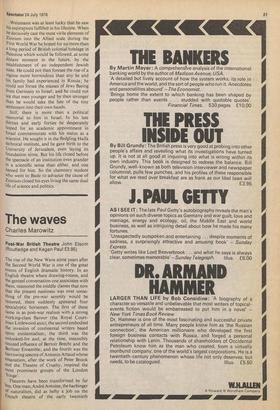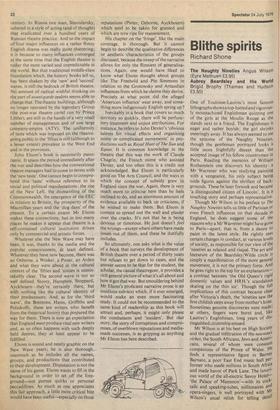The waves
Charles Marowitz Post-War British Theatre John Elsom (Routledge and Kegan Paul E3.95) The rise of the New Wave some years after the Second World War is one of the great events of English dramatic history. In an English theatre where drawing-rooms, and the genteel conversation one associates with them, reassured the middle classes that now that the present nastiness was over something of the pre-war serenity would be restored, there suddenly appeared four apocalyptic horsemen. The first of these Came in as post-war realism with a strong working-class flavour (the Royal CourtJoan Littlewood axis); the second embodied the invasion of continental writers based Upon existentialism; the third was the unlooked-for and, at the time, ostensibly resisted influence of Bertolt Brecht and the aerliner Ensemble; and the fourth was the harrowing spectre of Antonin Artaud whose emanation, after the work of Peter Brook and the Theatre of Cruelty, inspired the most prominent groups of the London fringe'.
Theatres have been transformed by far less. One man, Andre Antoine, the harbinger °f naturalism, did as hefty a job on the French theatre of the early twentieth century. In Russia one man, Stanislavsky, ushered in a style of acting (and of thought) that eradicated over a hundred years of Russian theatre practice. And so the impact of four major influences on a rather flimsy English drama was really quite shattering; it is because so many influences converged at the same time that the English theatre is today the most varied and unpredictable in the world. But that traditional middle-class foundation which, the history books tell us, has been shaken by the 'new' and 'second' waves, is still the bedrock of British theatre. No amount of radical wishful thinking on the part of avant-garde zealots seems able to change that. The theatre buildings, although no longer operated by the legendary Group (the post-war theatre cartel run by Prince Littler), are still in the hands of a very small number of managements and of one large company-empire (ATV). The uniformity of taste which was imposed on the theatregoing public in the 'fifties is still (although to a lesser extent) prevalent in the West End and in the provinces.
John Elsom's book is necessarily panoramic. It spans the period immediately after the war and describes how the conventional theatre managers had to come to terms with the `new taste'. One cannot begin to comprehend this 'taste' without reference to its social and political manifestations: the rise of the New Left, the dismantling of the Commonwealth, the emergence of the EEC in relation to Britain, the prosperity of the Macmillan years and the 'dog days' of the present. To a certain extent Mr Elsom makes these connections, but in too many places he makes it appear that theatre is a self-contained cultural institution driven only by commercial and artistic forces.
Whatever else the New Wave may have been, it was, thanks to the media and the popular consciousness, At least defined. Whatever they have now become, there was an Osborne, a Wesker, a Pinter, an Arden and what they were about in the cultural context of the 'fifties and 'sixties is unmistakably clear. The second wave is not so well defined. Storey, Hampton, Stoppard, Ayckbourn--theVre certainly there, but with nothing like the cultural identity of their predecessors. And, as for the 'third wave', the Brentons, Hares, Griffiths and Poliakoffs, these are writers who benefit from the theatrical history that iirepared the way for them. There is now an expectation that England must produce vital new writers and, as so often happens with such deeply held desires, they at least appear to be fulfilled.
Elsom is sound and neatly graphic on the New Wave years; he is also thorough, inasmuch as he includes all the names, groups, and productions that contributed to their development. Disputation is not the name of his game. Elsom wants to fill in the background in order to set off the foreground—not pursue quirks or personal peccadilloes. As much as one appreciates this fair approach, a little more critical bite would have been useful—especially on those reputations (Pinter, Osborne, Ayckbourn) which tend to be taken for granted and which are now ripe for reassessment.
His chapter on the `fringe', like the main coverage, is thorough. But it cannot begin to describe the qualitative differences or aesthetic characteristics of the groups discussed, because the sweep of the narrative allows for only the flimsiest of generalisations. Again, one would have liked to know what Elsom thought about groups like The Freehold and Pip Simmons in relation to the Grotowsky and Artaudian influences from which he claims they derive. Precisely at what point did the alleged 'American influence' wear away, and something more indigenously English spring up?
Inevitably in a book that covers so much territory so quickly, there will be perfunctory treatment and unjust attributions. For instance, he refers to John Dexter's `obvious talents for visual effects and organising mime or complicated movements' in productions such as Royal Hunt of The Sun and Equus. It is common knowledge in the theatre that this was the work of Claude Chagrin, the French mime who assisted Dexter, and too often this is a credit not acknowledged. But Elsom is particularly good on The Arts Council, and the ways in which the concept of subsidy grew in England since the war. Again, there is very much more to criticise here than he feels inclined to do, and an enormous amount of evidence available to back up criticisms, if he wished to make them. But Elsom is content to spread out the wall and plaster over the cracks. It's not that he is being devious or timorous. He just doesn't feel the wrongs—except where others have made issues out of them, and these he dutifully includes.
So ultimately, one asks what is the value of a book that surveys the development of British theatre over a period of thirty years but refuses to get down to cases, and the answer seems to be that for the student, the scholar, the casual theatregoer, it provides a rich general picture of what it's all about and how it got that way. But smouldering behind Mr Elsom's proficient narrative prose is an insidious sub-text which, if it ever emerged, would make an even more fascinating study. It could not be recommended to the same kind of readership as this book will attract and, perhaps, it might only please the combatants and 'insiders'. But that story, the story of corruptions and compromises, of overblown reputations and mediamade successes, is as gripping as anything Mr Elsom has here described.



































 Previous page
Previous page